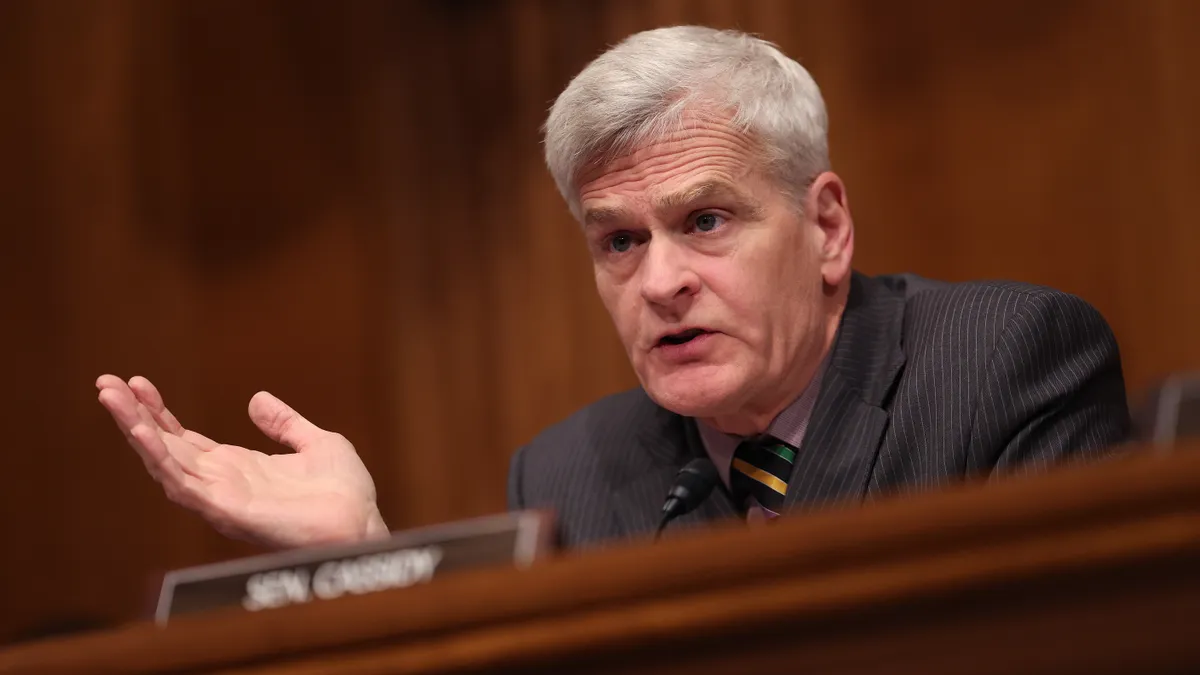As healthcare costs continue to rise in the U.S., payers and providers are scrambling to find new ways to eke out savings. But often the conversation fails to loop in the entities responsible for insuring more than 55% of the country: employers.
In the eyes of critics, employers — especially the country's largest — aren't doing enough to move the needle on medical costs and quality for their employees. But over the past year, some notable employers have partnered with traditional healthcare companies and struck out on their own to provide employees with out-of-the-box options to improve their health.
E-commerce giant Amazon launched a telehealth clinic for its employees in Seattle, and its troika with J.P. Morgan and Berkshire Hathaway to lower costs quietly rolled out health plans in select markets. The country's largest employer, Walmart, has also been proactive in the space, most recently starting a program diverting its employees to local, high-quality physicians. Industry also saw increasing adoption of workplace wellness programs, on-site clinics and efforts to narrow networks in direct contracting agreements and bundled payments.
A small subset of purchasers are testing these options while others watch and wait, experts say. But pressure on employers shows no sign of abating as cost increases continue to outpace overall inflation. A 2019 Mercer survey found health benefit costs for employers were projected to rise 4.4% in 2019, above the consumer price index and employee earnings growth. That's up from a slightly lower 3.6% growth the year prior.
Employers, as the backbone of the U.S. healthcare system, have a larger role to play, many say.
"Why are the CEOs of these organizations not as outraged as their employees over healthcare? What would have to happen to change that?," Chris Skisak, executive director for the Houston Business Coalition on Health, told Healthcare Dive. "Employers pay two to seven times more than Medicare for the exact same service. Is that not enough to say, 'We're mad as hell and we're not going to take it anymore'?"
Size, market concentration barriers to cost-cutting
Still, large employers can only do so much to branch out of traditional benefit design, as dynamics can vary widely in each local marketplace where an employer may provide coverage.
"Sometimes you see the very large employers being creative because they have the most at stake and they're thinking gosh, if we don't change things, the healthcare costs are really going to eat into our bottom line," Suzanne Delbanco, executive director of Catalyst for Payment Reform, told Healthcare Dive. "But it can also be very difficult in a nationally distributed population."
Experts say it's easier for small employers operating in a single geography to leverage their market share, look for area partnerships with payers and providers and deliver targeted solutions to their employees.
Because of this, small- and mid-market employers (companies with average annual revenue between $10 million and $1 billion, according to Ohio State University's National Center for the Middle Market) represent the best chance to drive value in healthcare as they typically have one health plan, a more personal relationship with their employees and can gather data in a unified way more easily than large employers.
Skisak noted it may not make sense for large employers to deploy limited programs that can't apply more broadly to all of their covered lives. "The fear of being able to provide things nationally is a barrier to disruptive innovation," he said.
But "depending on the market they're in [and] the concentration of employees, large employers have a good opportunity to do that too," Tom Parry, president of the nonprofit research group Integrated Benefits Institute, told Healthcare Dive.
For example, accountable care organizations, defined networks of providers striving to meet a set of quality and financial benchmarks, are a popular tool of commercial and public payers to manage patient care while cutting costs.
Companies as varied as airline manufacturer Boeing and tech giant Intel have developed ACOs in markets with a significant portion of employees. Intel's New Mexico program, created in tandem with integrated health system Presbyterian Healthcare Services, went live in 2013 and has since grown to span five regions in New Mexico, Oregon, Arizona and California where Intel has outsized employee populations — and reported results like decreased system waste, better management of chronic conditions and greater health engagement.
Large employers will increasingly turn to narrow, curated networks
Employers have been moving to narrower networks for some time now, a trend experts expect to gain traction in 2020. It's a pivot from the recent past, when employers commonly sought out broad networks to attract talent. A growing number of purchasers are now contracting directly with regional healthcare organizations to deliver targeted care, whether through bundled payments, carve-outs or Centers of Excellence for a condition or episode of care.
Walmart, the country's largest employer with 2.2 million employees, launched a Center of Excellence Network in 2013 that seeks to reduce unnecessary spinal surgeries by contracting with high-quality centers around the U.S., paying one flat fee for the entire episode of care. Employees who elect to receive surgeries outside of a COE are on the hook for out-of-network costs.
According to the Bentonville, Arkansas-based retailer, the COE has cut down on the roughly 50% of spinal surgeries found later to be unnecessary — data that's lent weight to these approaches, as opposed to them being just a flash in the pan.
Other major players like Lowe's, General Electric, Boeing and McKesson followed in Walmart's footsteps over the next few years, joining or creating their own COEs. According to the National Business Group on Health, employer use of some type of Centers of Excellence program rose to almost 90% percent in 2019, up from 80% in 2016.
Though experts worry somewhat about costs of operating COEs, benefits experts forecast more employers, bolstered by Walmart's success, will look into the option over the next few years.
Walmart unveiled another program late last year in an effort to steer employees to higher quality doctors. The so-called Featured Providers program has patients pay more if they choose to see a provider outside of a list curated by data analytics company Embold Health starting in Walmart's medical plans this year.
The program is being trialed in northwest Arkansas, Orlando and Tampa in Florida, and the Dallas-Fort Worth area with the goal of eventually expanding it to all U.S. Walmart and Sam's Club employees. It's another strategy to narrow networks: working with a smaller pool of providers who agree to lower prices in exchange for greater patient volume.
In the Houston area, for example, surveyed plan sponsors' interest in narrow network plan options doubled between 2018 and 2019, according to the Houston Business Coalition on Health. These plans, like HMOs and PPOs, have a smaller network of providers, typically tied to an accountable care organization or quality requirement. The approach is hardly new, but still gaining traction.
Of the employers offering narrow networks, 80% are building in financial incentives for employees to select those plans, according to a survey of HBCH's mid- to large-sized employers.
"The idea of trying to curate where a given number of members are getting care has really taken off," Delbanco said, rattling off tactics like narrow or tiered networks, reference pricing and Centers of Excellence. "All of these things are getting the attention of more sophisticated and progressive healthcare purchases as viable options to consider."
Insurance experts expect networks will winnow further as employers design benefits for the 2021 and 2022 plan years. There's a lot of fat to trim, according to the Kaiser Family Foundation: 55% of employers described the network of their most-utilized health plan as "very broad," 37% as "somewhat broad" and 7% as "somewhat narrow" in 2019.
And, though narrow networks, restricted provider lists and COEs have gotten pushback from patients for reducing choice — something that goes against the American ethos — such initiatives may be necessary to incentivize patients to go toward higher performing providers.
"It's very American to have the choice you want," Delbanco said. "But we're at that inflection point where people are willing to make a choice between cost and flexibility."
Healthy economy spurs focus on primary care, wellness and telehealth
Benefits, of course, are a key way employers can attract and retain talent, especially in a tight labor market. In 2020, savvy employers are likely to become active in rounding out their offerings to attract workers in a country with less than 4% unemployment, and keep them healthy and productive.
One prong of this sea change will push payers away from high-deductible health plans over the next few years, as the plans — meant to give employees financial skin in the game — caused patients to eschew both unnecessary and necessary care.
Nearly 70% of mid- to large employers offered HDHPs to employees last year. For 13%, an HDHP was the only option offered, according to Mercer.
"We've kind of hit a wall around increasing cost sharing and hitting high deductible plans and those consumer-oriented strategies," Michael Thompson, president and CEO of the National Alliance of Healthcare Purchaser Coalitions, told Healthcare Dive. "As cost sharing increases, it's outpaced people's ability to pay."
In the new year and beyond, experts forecast more employers will move to provide Advanced Primary Care systems, a primary care physician-centric model of delivery. In APC, the PCP isn't a gatekeeper into the health system but a navigator guiding employees to their best options possible through education, referrals, care coordination and more.
According to the HBCH, almost half of its members plan to pursue an advanced primary care strategy in 2020, with an addition 26% considering such a roadmap for 2022.
"Employers are investing more in primary care with an eye toward eliminating downstream costs, reducing admissions, being more discerning in terms of how referrals are made and more," Thompson said.
Industry is also seeing the beginning of a move toward health benefit design without a deductible altogether, experts say. Such plans are more focused on co-pays, trying to create a lower premium by, for example, narrowing the network or creating requirements, like having a primary care provider coordinate their care.
In November, J.P. Morgan and Amazon started offering health insurance through their cost-cutting venture Haven in select states for 30,000 workers in Ohio and Arizona with two separate plans, run by payers Cigna and Aetna. It's traditional insurance, except some of the plans don't require employees to pay deductibles or offer financial rewards for doing wellness activities.
It hints a shift towards trying to take patients off the hook for the price of their care, but "that's not exactly revolutionary," IBI's Parry said. "It really demonstrates how tough it is to change the healthcare system."
As stress increases to provide inexpensive preventive care, employers will continue to push wellness and telehealth programs onto their beneficiaries. Though utilization of both remains low, proponents say such initiatives hold down cost while bolstering holistic health.
Yet companies remain concerned. A September study from Willis Towers Watson found more than 80% of employers identified rising benefit costs as the main challenge they are facing over the next three years. As companies trying to turn the tide on health begin to report the results of their strategies, benefits expects can only hope more wary players follow in their footsteps and adopt solutions with proven outcomes.
"At the end of the day, employers have to put their hands on the steering wheel as purchasers of healthcare," Delbanco said. "They have to. Otherwise they'll be passive recipients of whatever comes their way."






















